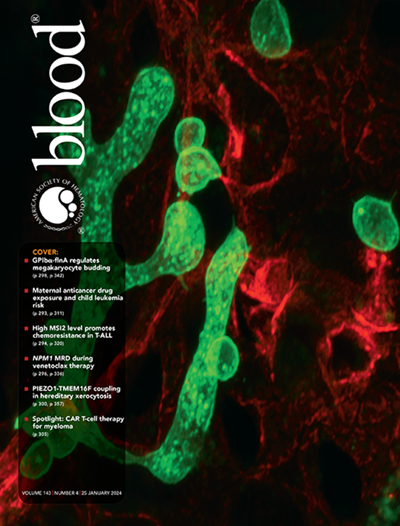遗传性口细胞增多症的演变景观。
IF 21
1区 医学
Q1 HEMATOLOGY
引用次数: 0
摘要
遗传性口细胞增多症是一种异质性的遗传性红细胞膜缺陷,以不同程度的溶血性贫血为特征,伴有细胞盐和水的改变,从脱水到过度水化,外周血涂片上存在口细胞。这种情况包括各种亚型,每个亚型都有不同的临床和遗传特征。这些疾病的病理生理学基础包括红细胞膜特性的改变,导致可变形性受损,阳离子渗透性和体积的改变,导致对溶血的易感性增加。在过去的几年中,基因检测的进步已经能够识别一些致病基因,如PIEZO1, KCNN4和ABCB6。这些遗传发现促进了对发病机制的分子机制的深入了解,并为提高诊断准确性和遗传咨询铺平了道路。本文综述了遗传性口细胞增多症的临床表现、病理生理、分子遗传学、诊断和治疗策略,重点介绍了脱水遗传性口细胞增多症、遗传性干性细胞增多症和肝铁超载领域的最新进展。后者与DHS的致病基因PIEZO1在肝脏和巨噬细胞水平上的生理作用直接相关。特别是,PIEZO1的功能获得突变解释了以不同表型为特征的多效性综合征,这取决于PIEZO1在多个细胞和组织中的表达。本文章由计算机程序翻译,如有差异,请以英文原文为准。
The evolving landscape of hereditary stomatocytosis.
Hereditary stomatocytosis represents a heterogeneous group of inherited erythrocyte membrane defects characterized by hemolytic anemia of variable degree, with alterations in cellular salt and water, ranging from dehydration to overhydration, and the presence of stomatocytes on peripheral blood smear. This condition encompasses various subtypes, each with distinct clinical and genetic features. The pathophysiology underlying these conditions involves altered red blood cell membrane properties, leading to impaired deformability, alterations in cation permeability and volume, causing increased susceptibility to hemolysis. Advancements in genetic testing have enabled the identification of some causative genes in the last years, such as PIEZO1, KCNN4, and ABCB6. These genetic discoveries have facilitated a deeper understanding of the molecular mechanisms underlying the pathogenesis and have paved the way for improved diagnostic accuracy and genetic counseling. This review provides an overview of the clinical presentation, pathophysiology, molecular genetics, diagnosis, and management strategies of hereditary stomatocytosis, highlighting recent advancements in the field of dehydrated hereditary stomatocytosis, or hereditary xerocytosis, and hepatic iron overload. This latter is directly associated with the physiological role of PIEZO1, the causative gene of DHS, at hepatic and macrophagic levels. Particularly, gain-of-function mutations in PIEZO1 account for a pleiotropic syndrome characterized by different phenotypes depending on the expression of PIEZO1 at multiple cells and tissues.
求助全文
通过发布文献求助,成功后即可免费获取论文全文。
去求助
来源期刊

Blood
医学-血液学
CiteScore
23.60
自引率
3.90%
发文量
955
审稿时长
1 months
期刊介绍:
Blood, the official journal of the American Society of Hematology, published online and in print, provides an international forum for the publication of original articles describing basic laboratory, translational, and clinical investigations in hematology. Primary research articles will be published under the following scientific categories: Clinical Trials and Observations; Gene Therapy; Hematopoiesis and Stem Cells; Immunobiology and Immunotherapy scope; Myeloid Neoplasia; Lymphoid Neoplasia; Phagocytes, Granulocytes and Myelopoiesis; Platelets and Thrombopoiesis; Red Cells, Iron and Erythropoiesis; Thrombosis and Hemostasis; Transfusion Medicine; Transplantation; and Vascular Biology. Papers can be listed under more than one category as appropriate.
 求助内容:
求助内容: 应助结果提醒方式:
应助结果提醒方式:


